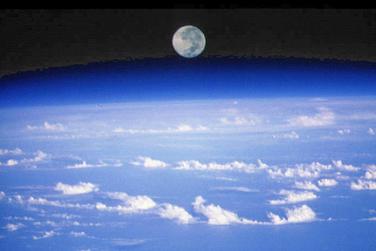Let's imagine you're not at your computer today. Instead, you're wiggling your toes in the sand at Malibu.
Everyone around you is dressed for the beach, of course, and when the reason for that was directly overhead at lunchtime, the waves of radiation fried a lot of that exposed skin. But now it's evening, the sun is preparing to depart, and the harshness has gone out of the rays. You know intuitively that some of the energy isn't getting through.
To understand why, imagine two circles, one inside the other. The larger circle represents our atmosphere and the other is the Earth. Now draw a vertical line through the twelve o'clock positions of each. This line represents the sun's rays at noon.
Now from the point where those rays hit the earth, draw a horizontal line through the atmosphere. This line represents the sun's rays at sunset.
Comparing the two, it's easy to see that the energy from the setting sun has to travel through more atmosphere, which absorbs more of the sun's energy, before reaching your skin; but there's also a more subtle effect at work here, caused by the molecules of water, oxygen, and other things in the air that bend the sun's rays so that they don't head straight at us—a phenomenon called refraction.
With more atmosphere comes more refraction, and here's the important part: When the sun is at the horizon, the light from the bottom of the sun must pass through just a little bit more air than the light from the top of the sun. The light from the bottom gets refracted upward, and so the sun appears squashed. Light from the left and right sides of the sun has to travel thorough the same amount of atmosphere, so this light is not spread out, and the sun's apparent horizontal dimension remains the same.
This squashing effect also happens to the moon when it is near the horizon.
The extent of the squashing varies with altitude and temperature, both of which alter the density of the atmosphere you're looking through. On a normal day in a place like Malibu, the sun can appear 1.2 times wider than it is tall. But in the Arctic, the sun can appear twice as wide. And from an airplane or the space shuttle, the width can appear 2.5 times greater than the height.
This refraction causes another effect you might have noticed. Because the bottom of the sun appears to be drawing up toward the top, the sun really does appear to slow down just before it sets.
Now as you ponder all of this from your beach in Malibu, you would probably not be alone if you argued, "Hey, you said the sun does not get wider, but I can see with my own eyes that it is much larger overall at sunset than it is at noon."
